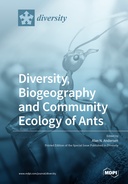Explore

Diversity, Biogeography and Community Ecology of Ants
0 Ungluers have
Faved this Work
Login to Fave
Ants are a ubiquitous, highly diverse, and ecologically dominant faunal group. They represent a large proportion of global terrestrial faunal biomass and play key ecological roles as soil engineers, predators, and re-cyclers of nutrients. They have particularly important interactions with plants as defenders against herbivores, as seed dispersers, and as seed predators. One downside to the ecological importance of ants is that they feature on the list of the world’s worst invasive species. Ants have also been important for science as model organisms for studies of diversity, biogeography, and community ecology. Despite such importance, ants remain remarkably understudied. A large proportion of species are undescribed, the biogeographic histories of most taxa remain poorly known, and we have a limited understanding of spatial patterns of diversity and composition, along with the processes driving them. The papers in this Special Issue collectively address many of the most pressing questions relating to ant diversity. What is the level of ant diversity? What is the origin of this diversity, and how is it distributed at different spatial scales? What are the roles of niche partitioning and competition as regulators of local diversity? How do ants affect the ecosystems within which they occur? The answers to these questions provide valuable insights not just for ants, but for biodiversity more generally.
This book is included in DOAB.
Why read this book? Have your say.
You must be logged in to comment.
Rights Information
Are you the author or publisher of this work? If so, you can claim it as yours by registering as an Unglue.it rights holder.Downloads
This work has been downloaded 95 times via unglue.it ebook links.
- 95 - pdf (CC BY) at Unglue.it.
Keywords
- ancestral state reconstruction
- ANT
- ant diversity
- antbird
- Ants
- army ant
- bait
- behavioral interactions
- Biodiversity
- Biogeography
- biological indicator
- Biological invasions
- burrow commensal
- centre of origin
- Climate Change
- climatic gradients
- co-occurrence
- Coexistence
- commensalism
- community structure
- competitive exclusion
- Conservation
- cryptic species
- Deforestation
- dispersal routes
- distribution ranges
- Diversity
- Dolichoderinae
- Dominance
- endemic species
- endosymbiont
- food specialisation
- Formicidae
- gopher tortoise
- Habitat fragmentation
- hypogaeic
- interactions
- invasion ecology
- invasive species
- Mimicry
- morphospecies
- myrmecophiles
- n/a
- phylogeny
- Physiology
- pitfall
- red imported fire ant
- Reference, information & interdisciplinary subjects
- refugium areas
- Research & information: general
- sampling methods
- Scale
- soil arthropods
- species checklist
- species delimitation
- species distribution models
- Species interactions
- species occurrence
- species richness
- stratification
- sympatric association
- temperature
- thema EDItEUR::G Reference, Information and Interdisciplinary subjects::GP Research and information: general
- Tropics
- turnover
- urban ecology
- vertical transmission
- wet tropics
Links
DOI: 10.3390/books978-3-0365-2787-1Editions

